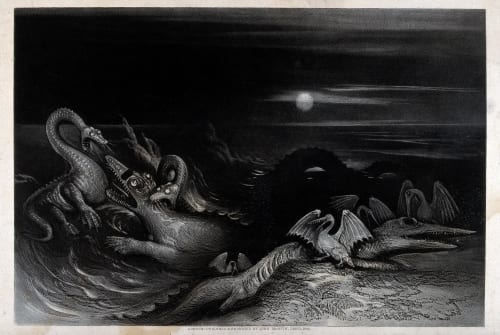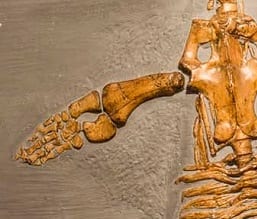Specimen of the Week 205: The Plesiosaur
By Tannis Davidson, on 14 September 2015
This week’s Specimen of the Week is one of the largest single objects in the Grant Museum, but it is one which is often overlooked. Tucked away along the wall behind the large elephant skull, many who visit the Museum miss it as they are drawn to the illuminated cave which is the Micrarium. The warm glow of over 2300 backlit microscope slides attracts the eye, but also diverts attention from the dim end-of-corridor/rope-barrier/back-entrance-to-the-office area which is home to the specimen of which I speak.
This week’s Specimen of the Week is…
**The Plesiosaur cast**
1. An oldie but a goodie
This cast of Thalassiodracon hawkinsi has been in the Grant Museum collection for at least 125 years. It appears in the catalogue produced by Lankester in 1890 as ‘Plesiosaurus hawkinsii‘ (as it was previously known):
The original specimen (from which this was cast was made) was discovered in the early 1830’s by the geologist Thomas Hawkins in Street, Somerset. It was initially described and named by Sir Richard Owen as Plesiosaurus hawkinsii and was designated the holotype of that species (1). In 1996 it was reassigned to the genus Thalassiodracon with the species name hawkinsi (2). The original fossil can be seen in the Fossil Marine Reptiles gallery at the Natural History Museum in London.
2. Sea dragon
Thalassiodracon “sea dragon” was a genus of small pliosaur placed in the family Pliosauridae within the order Plesiosauria. Carnivorous marine reptiles, they measured around 1.5 – 2 metres in length with the skull being quite large in relation to the body – possibly for hunting smaller marine reptiles as well as fish. T. hawkinsi is the only species in the genus and is known from several nearly complete specimens found in the Blue Lias and White Lias geological formations in the UK. They lived during the late Triassic to early Jurassic periods around 195-200 million years ago.
3. One stop shopping
In 1862, the American naturalist and geologist Henry Augustus Ward set up a business selling various natural history educational materials including taxidermy specimens, geological samples and “an extensive holding of casts of fossils of all sorts” (3). The company, known as Ward’s Natural Science Establishment, still exists today.
By 1866 a catalogue was produced “Casts and Fossils From the Principle Museums of Europe and America with Short Descriptions and Illustrations” which included no less than 1207 fossil casts available for purchase (4). One of the highlighted specimens (with illustration and description) was none other than ‘our’ plesiosaur cast:
Descibed as a ‘skeleton on slab’ measuring 6 ft. x 2 ft 9 inches, this cast could be obtained for the very reasonable cost of $18.00. Listed under its pre-Owen-described name, it is, nonetheless, unmistakably the same specimen as X227.
Whether or not the Grant Museum ordered what is now known as LDUCZ-X227 from Ward’s catalogue is unknown. However, the Museum does have a well-worn copy of Ward’s catalogue in its archives and the chronology fits, so it is certainly within the realm of possibilty that the plesiosaur cast was obtained from this source.
4. The illustrated beast
Ward’s fossil casts made every attempt to be true to the original, as did Hawkins himself. Hawkins not only carefully reassembled the fossil skeletons he collected, but he included detailed illustrations of specimens in his publications – notably Memoirs of Icthyosaurii and Plesiosaurii (1835) and The Book of the Great Sea Dragons (1840).
Reconstructions of the plesiosaurs and ichthyosaurs featured in these texts are rather more fantastical. Epitomised by the frontispiece of The Book of Great Sea Dragons, John Martin’s famous ‘battling sea-saurians’ is a classic expression of fossil saurian’s impact on the Romantic ‘Gothick’ imagination. Perhaps best described by Hawkins, this evocative image captures the sense of fascination in strange extinct animals that continues today:
Looking back retrospective far over the wintry Ocean, into Pre-adamic Shades, we encounter execrable and dreary thins in the abounding Chaos. Through briny clouds incumbent impetuous Monsters gleam phrenitic, livid, or green, or swarthy snakes, quadrupedal and deadly. Wide over the desolate Seas warring Dragons innumerable and hideous, enacting Perdition…Martin has attained, with all his stupendous Powers, the utter hideousness…Giant of Wrath and Battle, behold! The Great Sea Dragon, the Emperor of Past Worlds, maleficent, terrible, direct, sublime. (5).

A nocturnal scene with saurians and sea-creatures fighting each other in the water. Mezzotint by J. Martin (1840) CC BY 4.0
Tannis Davidson is Curatorial Assistant at the Grant Museum of Zoology
References
 Close
Close





